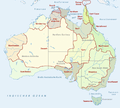Aṉangu facts for kids
Anangu (pronounced with the stress on the first part) is a word used to talk about Aboriginal people in Australia. You'll find this word in some dialects of the Western Desert Language (WDL). This language is spoken in parts of western and central Australia.
Before European people came to central Australia, anangu probably meant 'human being' or 'person'. Today, it is mostly used to mean 'Aboriginal person'. Other Aboriginal languages have their own words for 'person'. So, anangu is mainly used in English to refer to people who speak the WDL. When used this way, it means all WDL-speaking people, not just one specific group or tribe. In the Pitjantjatjara language, the correct term for "black person" is aṉangu maru, which means "dark/black person".
Different Names for Aboriginal People
Other Western Desert Language dialects have different words that mean something similar to anangu. These words are used in many ways. For example, in the far west of the WDL area, people use the word martu. This includes groups like the Manyjilyjarra, Kartujarra, Putijarra, and Warnman people. In the central Western Desert, among the western Pintupi people, the word purntu was used. However, this word is not used very often anymore.
There are also other names from Australian Aboriginal languages. These names are often used to identify groups based on where they live. Here are some examples:
- Koori (or Koorie) is used in New South Wales and Victoria.
- Murri is used in southern Queensland.
- Nyoongar is used in southern Western Australia and South Australia.
- Nunga is used in southern South Australia.
- Palawah (or Pallawah) is used in Tasmania.
Images for kids
-
Map of Indigenous Australian cultural regions; the Western Desert cultural bloc is marked "Desert."


